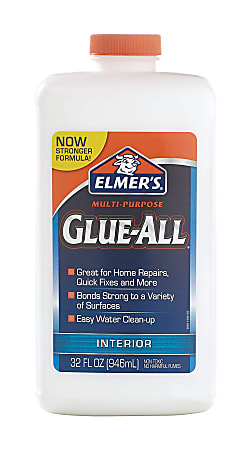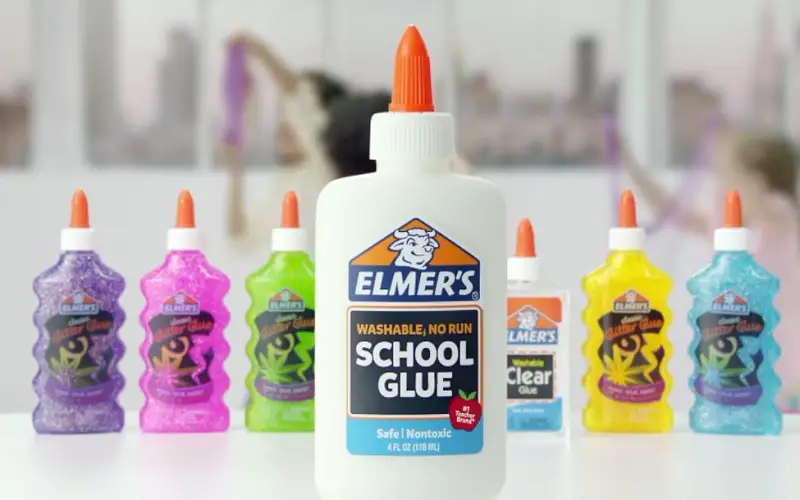Yes, Elmer’s glue is non-toxic and safe for use. It is a water-based adhesive.
Elmer’s glue is a popular choice for arts and crafts projects, as well as for use in schools and households. It is non-toxic, meaning it does not pose a threat to human health when used as intended.
This makes it a suitable option for children’s activities and various DIY projects. However, it’s important to always use any adhesive product according to the manufacturer’s guidelines to ensure safety and best results.
Contents
Introduction To Elmer’s Glue
Elmer’s Glue is a well-known adhesive product that has been a staple in households, schools, and offices for many years. It is a versatile and reliable glue that is trusted by many for various crafting and DIY projects.
The Popularity Of Elmer’s Glue
Elmer’s Glue has gained immense popularity due to its effectiveness, affordability, and wide availability. It has become a household name synonymous with quality adhesive products.
Common Uses In Everyday Life
Elmer’s Glue is commonly used for arts and crafts projects, school assignments, repairing items, and even for creating slime. Its non-toxic formula makes it safe for children to use under adult supervision.
Composition Of Elmer’s Glue
Elmer’s Glue is a popular adhesive that is commonly used in schools, households, and craft projects. It is known for its strong bonding capabilities and versatility.
Understanding the composition of Elmer’s Glue can provide insight into its properties and potential concerns regarding toxicity.
Key Ingredients
Elmer’s Glue primarily consists of polyvinyl acetate (PVA), water, and other additives. PVA is the main adhesive component that creates the bond when the glue dries.
The presence of water allows the glue to be spread easily and then evaporates during the drying process. Additionally, various additives such as preservatives and stabilizers are included to enhance the glue’s shelf life and performance.
The Role Of Pva
Polyvinyl acetate (PVA) is a synthetic polymer that is responsible for the adhesive properties of Elmer’s Glue. When PVA comes into contact with a surface, the water in the glue begins to evaporate, causing the PVA molecules to bond together and adhere to the surface.
This results in a strong and durable bond that is capable of adhering to a wide range of materials, making it suitable for various applications.
Toxicity Concerns
Parents often wonder about the toxicity concerns surrounding Elmer’s glue and its potential health risks. Let’s explore the safety aspects and certifications in detail.
Potential Health Risks
Children may face potential health risks if Elmer’s glue is ingested or comes in contact with their eyes or skin.
Safety Certifications
Elmer’s glue typically meets safety certifications to ensure it is non-toxic and safe for use by both children and adults.
Comparative Analysis
When it comes to choosing an adhesive for your arts and crafts projects, it is important to consider the toxicity levels of the glue products.
In this comparative analysis, we will be looking at Elmer’s Glue and other popular adhesives to determine their toxicity levels.
Elmer’s Vs. Other Adhesives
Elmer’s Glue is a popular choice for many craft enthusiasts due to its affordability and versatility. However, it is crucial to understand how it compares to other adhesives in terms of toxicity levels.
Toxicity Levels In Glue Products
When it comes to the safety of glue products, it is essential to consider the potential risks associated with their use. Here is a comparative analysis of the toxicity levels in glue products:
| Glue Product | Toxicity Level |
|---|---|
| Elmer’s Glue | Low |
| Super Glue | High |
| Hot Glue | Low |
| Wood Glue | Low |
| Glue Stick | Low |
Elmer’s Glue stands out in terms of toxicity levels as it falls under the low toxicity category. This makes it a safer option compared to other adhesives such as Super Glue, which has a high toxicity level.
Additionally, hot glue, wood glue, and glue sticks also have low toxicity levels, making them relatively safe choices for various craft projects.
It is important to note that while Elmer’s Glue is considered low in toxicity, it is still recommended to use it in a well-ventilated area and avoid prolonged exposure or ingestion. Always follow the instructions provided by the manufacturer for safe and proper use.
In conclusion, when choosing an adhesive for your projects, considering the toxicity levels is crucial. Elmer’s Glue, along with other low toxicity options like hot glue, wood glue, and glue sticks, can provide a safer alternative for your crafting needs.
Regulatory Standards
Elmer’s Glue adheres to regulatory standards and is non-toxic, ensuring the safety of users. It meets all necessary guidelines and can be used with peace of mind for various projects.
Fda Regulations
The United States Food and Drug Administration (FDA) has strict regulations regarding the safety of products that come into contact with food.
Elmer’s glue is classified as a non-food product, but it still falls under the FDA’s jurisdiction. The FDA requires that all non-food products, including Elmer’s glue, be labeled with warnings if they contain any hazardous substances.
Consumer Product Safety Commission
The Consumer Product Safety Commission (CPSC) is a U.S. government agency that regulates the safety of consumer products. Elmer’s glue is considered a consumer product, so it must adhere to CPSC safety regulations.
The CPSC requires that all consumer products, including Elmer’s glue, undergo safety testing and meet certain safety standards before they can be sold to the public. Despite the regulatory standards in place, some people may still wonder if Elmer’s glue is toxic.
While Elmer’s glue is generally safe for children to use, it is important to follow the instructions on the label and use the product as intended.
If you have any concerns about the safety of Elmer’s glue or any other product, it is always best to consult with a healthcare professional or contact the manufacturer for more information.

Safe Handling Practices
Elmer’s glue is non-toxic and safe for children to use. However, it is important to follow safe handling practices, such as avoiding ingestion and keeping it away from eyes and mouth. Always read the label and use as directed.
Elmer’s Glue is a widely-used adhesive in various crafts and projects, but it’s important to handle it safely to avoid any potential risks.
By following proper usage guidelines and knowing how to respond in case of accidental exposure, you can ensure a safe experience. Here are some key practices to keep in mind:
Proper Usage Guidelines
When working with Elmer’s Glue, it’s essential to follow these guidelines to minimize any potential harm:
1. Use in a well-ventilated area: Ensure that you are working in a space with adequate airflow to avoid inhaling any fumes that may be released during use.
2. Avoid direct contact with skin and eyes: Elmer’s Glue is generally safe to use, but prolonged exposure or contact with sensitive areas can cause irritation. To prevent this, it’s recommended to wear gloves and goggles when handling the glue.
3. Keep away from children: Elmer’s Glue should be stored out of reach of children to prevent accidental ingestion or misuse. Always supervise children when they are using glue and teach them the importance of safe handling.
4. Read and follow the label instructions: Before using Elmer’s Glue, carefully read the instructions provided on the packaging. This will ensure that you are using the product correctly and following any specific safety precautions.
First Aid For Accidental Exposure
In the event of accidental exposure to Elmer’s Glue, it’s crucial to know how to respond promptly. Here are some first aid measures to consider:
1. Skin contact: If glue comes into contact with your skin, gently wash the affected area with soap and warm water. Avoid using any harsh chemicals or scrubbing vigorously, as this may cause further irritation.
2. Eye contact: If Elmer’s Glue gets into your eyes, immediately flush them with lukewarm water for at least 15 minutes. Remove any contact lenses if possible, but do not rub your eyes. Seek medical attention if irritation persists.
3. Ingestion: If someone ingests Elmer’s Glue, it is essential to seek medical help immediately. Do not induce vomiting unless instructed to do so by medical professionals.
4. Inhalation: If you inhale excessive fumes or vapors from Elmer’s Glue, move to an area with fresh air. If symptoms such as dizziness or difficulty breathing persist, seek medical assistance.
Remember, while Elmer’s Glue is generally safe to use, accidents can happen. By practicing proper handling techniques and knowing how to respond in case of accidental exposure, you can ensure a safe and enjoyable crafting experience.
Elmer’s In Educational Settings
Elmer’s Glue is a common sight in educational settings, from elementary classrooms to art studios. The use of Elmer’s Glue in these environments raises questions about its safety, especially when it comes to young children and crafting activities.
Let’s explore some precautions and safety measures to ensure the safe use of Elmer’s Glue in educational settings.
Precautions For Young Children
When using Elmer’s Glue with young children, it’s important to supervise them closely to prevent ingestion or misuse. Always store the glue out of reach and educate children on its proper use. Encourage them to keep the glue away from their mouths and to wash their hands after using it.
Crafting Safety In Schools
In school settings, teachers should provide clear instructions on the safe use of Elmer’s Glue during crafting activities. It’s essential to create a well-ventilated workspace and ensure that children use the glue in a controlled manner. Additionally, teachers should be prepared to handle any accidental spills or contact with skin or eyes.
Environment And Sustainability
When it comes to the environment and sustainability, it’s essential to consider the impact of products we use on the planet. One common household item that raises questions about its eco-friendliness is Elmer’s Glue.
Biodegradability Of Elmer’s Glue
Elmer’s Glue is primarily made from polyvinyl acetate, a synthetic polymer. While it is not biodegradable, it is considered non-toxic and safe for the environment. This means that although it doesn’t break down naturally, it doesn’t pose a threat to the ecosystem when used and disposed of properly.
Environmental Impact Considerations
When considering the environmental impact of Elmer’s Glue, it’s important to note that its production process and raw materials can have consequences. The extraction and manufacturing of the raw materials, as well as the energy used in production, contribute to its overall environmental footprint.
However, Elmer’s Products, Inc. has taken steps to reduce its environmental impact by implementing sustainable practices and using renewable resources where possible.

Frequently Asked Questions
Is Elmer’s Glue Toxic To Humans?
Elmer’s glue is generally non-toxic to humans. It is made from water and a synthetic adhesive called polyvinyl acetate.
However, it is still important to avoid ingesting or inhaling large amounts of the glue, as it may cause mild digestive discomfort or respiratory irritation.
What Happens If A Child Eats Elmer’s Glue?
Ingesting Elmer’s glue can cause stomach upset, but it’s generally non-toxic and not life-threatening. However, seek medical advice.
Is Elmer’s Glue Safe To Put On Your Face?
No, Elmer’s glue is not safe to put on your face. It is not formulated for skin contact and may cause irritation.
Is Elmers Glue A Hazardous Chemical?
Elmer’s glue is not considered a hazardous chemical. It is safe for regular use.
Conclusion
Understanding the potential toxicity of Elmer’s Glue is essential for safe usage. By being aware of its ingredients and following proper handling guidelines, you can ensure a secure experience. Prioritizing safety and informed decision-making is key when using any household products.

